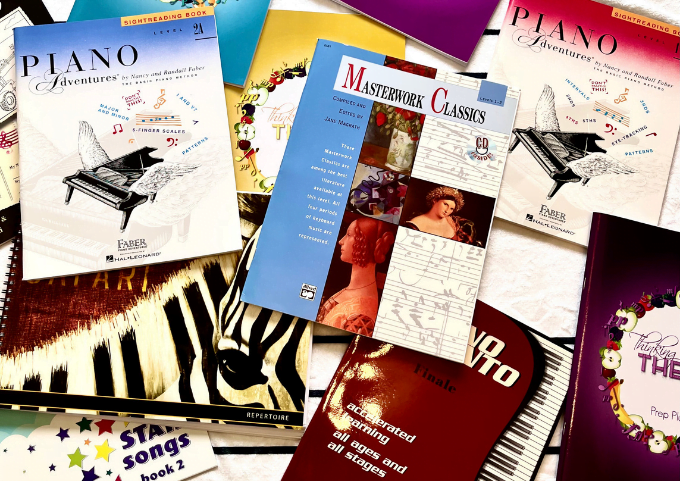
This blog post about developing your piano studio brand was written by Amanda Shaw. Amanda lives with her family on a little island near Montreal, Quebec. She’s a homegrown teacher who loves to share her passions with others. When she’s not homeschooling her own three kids, she’s teaching piano, English literature or ESL. The most heard phrase in her studio (and the one which elicits the most giggles and groans from her students) is “Play it again!”
Whether you know it or not, your music studio has a brand. The way you teach, the people you teach, the method books you choose to use – all these and more define you as a teacher and what type of student is the best fit for your studio.

What does it mean to take music lessons with you?
Your piano studio brand prioritises your strengths and is honest about your weaknesses. It differentiates you, as a teacher, from the dozen other piano teachers in your area.
Building your brand should be a conscious choice, but it doesn’t have to be an agonising one.
If you think through the six key areas below, you’ll narrow down what it means for a student to take music lessons with you and what piano-teaching success looks like to you.
Defining Your Music Teaching Studio Brand
Grab a pen and some paper or open a new file on your laptop to answer the questions below. Step-by-step, you’ll see your music teaching studio brand unfold.
Step 1: Your Background
How did you learn piano? Do you teach the way you learnt, or in a different way? Why? Any defining experiences in your own musical journey?
I recently spoke to a professional pianist who told me she learnt piano in a very classical, traditional way, passing the Canadian Royal Conservatory exams and memorising pieces for recitals. But her university studies took her down the path of jazz (a very different beast!) and her approach to both performing and teaching was forever changed.
Maybe you remember a fun game your favourite music teacher played with you – one which made you look forward to your lessons each week. Or maybe you remember a certain set of warm-up exercises which struck fear in your heart, and you never want to put your own students on the spot like that.
Whatever the case, your own background will likely have a big impact on your way of teaching. It can help you pinpoint what you’re passionate about. Take a few minutes to jot down your thoughts and watch your piano studio brand begin to take shape!
Step 2: Your Curriculum
Think about the content of your curriculum:
- Do you swear by a particular method book, or are you willing to work with whatever books the parent picked up already?
- Do you insist upon a certain methodology such as Suzuki?
- Do you love jazz or contemporary music?
- Are you comfortable teaching pop music?
The answers to these types of questions will determine not only which students you attract but also which ones you retain.

Think about your current and past students and your teaching journey with them. Make sure you’re upfront with new students about your typical teaching path and whether you’re willing or not to deviate from it.
Step 3: Your Teaching Style
Some teachers have a list of items to check off during the lesson, while others are comfortable playing it by ear.
- Do you always want to start with a warm-up, or are you ok with letting your student decide what he or she wants to do first?
- How do you respond to students who haven’t practised all week?
- Do you have a reward system in place?
- Maybe you’re the teacher with several tricks up your sleeve to work with aural, visual and kinesthetic learners.
Think about it this way: How would you describe the perfect piano lesson? What lesson structure leaves both you and your students feeling the most satisfied? Is it the same for both of you, or is a compromise involved?
How you pass that 30, 45 or 60 minutes with your student is a big piece of your music-studio-brand puzzle. It’s what your students will talk about with their parents, and what their parents will talk about with others.
Step 4: Your Current Clientele
Take a look at the current makeup of your student group. Are your students all about the same age, or are you constantly readjusting the height of your piano bench? Perhaps – without realising it – you’ve earned a reputation for being particularly good with preschoolers, or maybe your evening lesson hours attract teens.
Be honest about your strengths but also about your limits. Identifying the age and experience level of your happiest customers allows you to focus and find your niche.
Step 5: Logistics
This may seem like you’re getting too far into the weeds, but details can seal the deal – or be deal-breakers – for many students.
- What length of lesson do you recommend (or require!) at each level?
- What’s your missed-class policy?
- Do you teach on the weekends?
- Can you accommodate siblings with back-to-back lessons?
Your schedule will have a big impact on which and how many students you can accommodate at your music studio. Do you want to grow your brand, hire more teachers or even open up more studio locations? Or do you prefer to stay small and intimate?
The price of your lessons and your payment schedule will also have an impact on how many students you attract as well as the perceived value of your lessons. Hitting that sweet spot isn’t always easy. Research the cost of lessons in your area, consider what is included in your own brand and also put a reasonable value on your time, for both the lesson and your preparation time.
How you answer these questions will have a huge impact on your own overall satisfaction as a teacher. Make sure your policies are clearly stated from the beginning so that everyone is happy.
Step 6: Extras
Do you offer an end-of-the-year concert? Are there group lessons available? Do you prepare students for exams?

Performance opportunities or regular progress updates with parents are extras which you may offer. Make sure potential students know about it.
These options can add to the attractiveness and perceived value of your piano studio brand. Your students should feel part of something – a community – which comes with special privileges and opportunities. That sense of belonging is key in retaining students.
Spreading the Word
Once you’ve answered these questions for yourself and defined your music studio brand, it’s time to communicate it to others. Pick a few colours and even a logo which matches your brand. Keep them consistent across posters, your website, your social media accounts and any other advertising materials.
Social media platforms and a blog are great ways to establish lines of communication with your students, their parents and potential clients. Post regularly about topics which speak to you and are in line with your music studio brand values. Make sure to use keywords which will get you found by students looking for teachers like you—words like improvisation, piano band, teen group lessons, classical music etc.
Seem like a lot? Start small. And always bring it back to this: why do I teach the way I do? Having a clear idea of where you’ve been, where you are and where you’re going in your teaching will help you attract the ideal students for you and build your own, unique music studio brand.
What does your music teaching studio brand say about you?
Did these steps reveal something about your piano studio brand you hadn’t realised before? Share your thoughts in the comments below.
You can find more marketing secrets on Nicola’s hub page devoted to all-things business.

Thank you. This was very helpful.